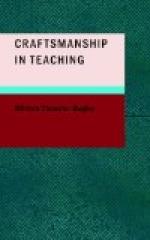IV
Thus far it seems clear that an absolute standard is available for testing the efficiency of training or habit building, and that a fairly accurate standard may be developed for testing the efficiency of instruction. Both training and instruction, however, are subject to the modifying influence of a third factor of which too little account has hitherto been taken in educational discussions. Training results in habits, and yet a certain sort of training may not only result in a certain type of habit, but it may also result in the development of something which will quite negate the habit that has been developed. In the process of developing habits of neatness, for example, one may employ methods that result in prejudicing the child against neatness as a general virtue. In this event, although the little specific habits of neatness may function in the situations in which they have been developed, the prejudice will effectually prevent their extension to other fields. In other words, the general emotional effect of training must be considered as well as the specific results of the training. The same stricture applies with equal force to instruction. Instruction imparts knowledge; but if a man knows and fails to feel, his knowledge has little influence upon his conduct.
This factor that controls conduct when habit fails, this factor that may even negate an otherwise efficient habit, is the great indeterminate in the work of teaching. To know that one has trained an effective habit or imparted a practical principle is one thing; to know that in doing this, one has not engendered in the pupil’s mind a prejudice against the very thing taught is quite another matter.
That phase of teaching which is concerned with the development of these intangible forces may be termed “inspiration”; and it is the lack of an adequate test for the efficiency of inspiration that makes the task of supervision so difficult and the results so often unsatisfactory.
Nevertheless, even here the outlook is not entirely hopeless. One may be tolerably certain of at least two things. In the first place, the great “emotionalized prejudices” that must come predominantly from school influences are the love of truth, the love of work, respect for law and order, and a spirit of cooeperation. These factors undoubtedly have their basis in specific habits of honesty, industry, obedience, and regard for the rights and feelings of others; and these habits may be developed and tested just as thoroughly and just as accurately as habits of good spelling and correct syntax. Without the solid basis of habit, ideals and prejudices will be of but little service. The one caution must be taken that the methods of training do not defeat their own purpose by engendering prejudices and ideals that negate the habits. It is here that the personality of the teacher becomes the all-important factor, and the task of the supervisor is to determine whether the influence of the personality is good or evil. Most supervisors come to judge of this influence by an undefined factor that is best termed the “spirit of the classroom.”




